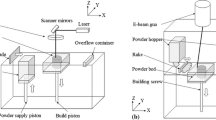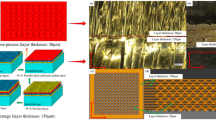Abstract
Springback is defined as a geometric defect, which occurs due to elastic recovery in the part after it has been unloaded. This challenge is most common in lightweight alloys as well as in advanced high strength steels. The materials, which exhibit lower elastic modulus or higher tensile strength, would be more prone to springback. In this paper, a novel patented technique is introduced to eliminate the springback by using rollers in the forming tool. It was found that due to the rotation of rollers in the tool during forming, reduces the stress in the part and, thus reduces the springback.











Similar content being viewed by others
Abbreviations
- YS:
-
Yield Strength, MPa
- TS:
-
Tensile Strength, MPa
- %EL:
-
Percentage Elongation
- K:
-
Strength Coefficient, MPa
- n:
-
Strain Hardening Exponent
- 40CCW:
-
40 Roller rotations in counter clockwise direction
- 80CCW:
-
80 Roller rotations in counter clockwise direction
- 40CW:
-
40 Roller rotations in clockwise direction
References
Hilditch, T. B., Speer, J. G., & Matlock, D. K. (2007). Influence of low-strain deformation characteristics of high strength sheet steel on curl and springback in bend-under-tension tests. Journal of Materials Processing Technology,182(1–3), 84–94.
Wagoner, R. H., & Li, M. (2007). Simulation of springback: Through-thickness integration. International Journal of Plasticity,23(3), 345–360.
Cheng, H. S., Cao, J., & Xia, Z. C. (2007). An accelerated springback compensation method. International Journal of Mechanical Sciences,49(3), 267–279.
Wagoner, R. H., Lim, H., & Lee, M. G. (2013). Advanced issues in springback. International Journal of Plasticity,45, 3–20.
Narasimhan, N., & Lovell, M. (1999). Predicting springback in sheet metal forming: An explicit to implicit sequential solution procedure. Finite Elements in Analysis and Design,33(1), 29–42.
Li, K. P., Geng, L. M., & Wagoner, R. H. (1999). Simulation of springback with the draw/bend test. In Proceedings of the 2nd international conference on intelligent processing and manufacturing of materials, vol. 1. IPMM’99. IEEE, 1999.
Gau, J. T., & Kinzel, G. L. (2001). A new model for springback prediction in which the Bauschinger effect is considered. International Journal of Mechanical Sciences,43(8), 1813–1832.
Lee, S. W., & Kim, Y. T. (2007). A study on the springback in the sheet metal flange drawing. Journal of Materials Processing Technology,187, 89–93.
Mori, K., Akita, K., & Abe, Y. (2007). Springback behaviour in bending of ultra-high-strength steel sheets using CNC servo press. International Journal of Machine Tools and Manufacture,47(2), 321–325.
Lobdell, M. A., Nikhare. C. P., & Roth. J. T. (2013). An electric touch for aluminum springback elimination. In Proceedings of international deep-drawing research group, Zurich, Switzerland.
Hill, R. (1948). A theory of the yielding and plastic flow of anisotropic metals. Proceedings of the Royal Society of London, Series A: Mathematical and Physical Sciences,193(1033), 281–297.
Barlat, F., Brem, J. C., Yoon, J. W., Chung, K., Dick, R. E., Lege, D. J., et al. (2003). Plane stress yield function for aluminum alloy sheets—Part 1: Theory. International Journal of Plasticity,19(9), 1297–1319.
Chaboche, J. L. (1989). Constitutive equations for cyclic plasticity and cyclic viscoplasticity. International Journal of Plasticity,5(3), 247–302.
Yoshida, F., & Uemori, T. (2002). A model of large-strain cyclic plasticity describing the Bauschinger effect and workhardening stagnation. International Journal of Plasticity,18(5–6), 661–686.
Lee, M. G., Chung, K., Kim, D., Kim, C., Wenner, M. L., & Barlat, F. (2005). Spring-back evaluation of automotive sheets based on isotropic-kinematic hardening laws and non-quadratic anisotropic yield functions: Part I: Theory and formulation. International Journal of Plasticity,21(5), 861–882.
Zang, S. L., Guo, C., Thuillier, S., & Lee, M. G. (2011). A model of one-surface cyclic plasticity and its application to springback prediction. International Journal of Mechanical Sciences,53(6), 425–435.
Larsson, R., Björklund, O., Nilsson, L., & Simonsson, K. (2011). A study of high strength steels undergoing non-linear strain paths—Experiments and modelling. Journal of Materials Processing Technology,211(1), 122–132.
Eggertsen, P. A., & Mattiasson, K. (2009). On the modelling of the bending–unbending behaviour for accurate springback predictions. International Journal of Mechanical Sciences,51(7), 547–563.
Yoshida. F. (2010). Material models for accurate simulation of sheet metal forming and springback. In AIP conference proceedings, vol. 1252, no. 1. AIP.
Zhu, Y. X., Liu, Y. L., Yang, H., & Li, H. P. (2012). Development and application of the material constitutive model in springback prediction of cold-bending. Materials and Design,42, 245–258.
Nikhare, C. P. (2016). Die for reducing springback and process there of. U.S. Patent No. 9,498,812. November 22, 2016.
Grüebler, R., & Hora, P. (2009). Temperature dependent friction modeling for sheet metal forming. International Journal of Material Forming,2(1), 251–254.
Klocke, F., Trauth, D., Shirobokov, A., & Mattfeld, P. (2015). FE-analysis and in situ visualization of pressure-, slip-rate-, and temperature-dependent coefficients of friction for advanced sheet metal forming: Development of a novel coupled user subroutine for shell and continuum discretization. The International Journal of Advanced Manufacturing Technology,81(1–4), 397–410.
Acknowledgements
Author would like to thank Penn State Erie, the Behrend College for undergraduate research scholarship, open lab research facilities and resources and Mr. Glenn Craig for tool manufacturing and specimen fabrication.
Author information
Authors and Affiliations
Corresponding author
Additional information
Publisher's Note
Springer Nature remains neutral with regard to jurisdictional claims in published maps and institutional affiliations.
Rights and permissions
About this article
Cite this article
Nikhare, C.P. Springback Reduction by Using Tool Rollers. Int. J. Precis. Eng. Manuf. 21, 67–74 (2020). https://doi.org/10.1007/s12541-019-00205-x
Received:
Revised:
Accepted:
Published:
Issue Date:
DOI: https://doi.org/10.1007/s12541-019-00205-x




